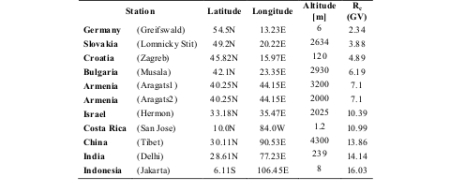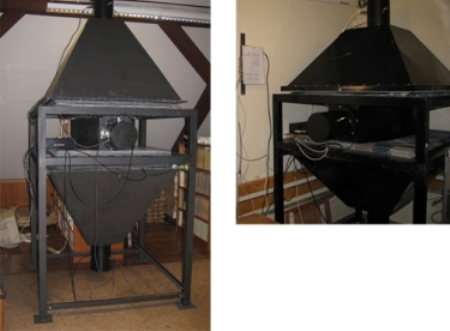
| 2008-12-22 12:33:27 |
|
SEVAN Network expanding To Bulgaria and Croatia
SEVAN (Space Environmental Viewing and Analysis Network) network of particle detectors located at middle to low latitudes aims to improve fundamental research of the particle acceleration in the vicinity of the sun and the space environments. The new type of particle detectors will simultaneously measure changing fluxes of most species of secondary cosmic rays, thus turning into a powerful integrated device used for exploration of solar modulation effects. The first four SEVAN modules operate at Aragats Space Environmental Center in Armenia, at altitudes 1000, 17000, 2000 and 3200 m in Yerevan and on the slopes of mountain Aragats. The expansion of SEVAN networks continuous in 2008 by deploying detectors in Croatia and Bulgaria; in 2009 we plan to deploy detectors in Slovakia and India.
Ground based particle detectors measure time series of secondary particles born in cascades which originatie in the atmosphere caused by primary ions and solar neutrons. The networks of particle detectors can predict upcoming geomagnetic and radiation storms hours before the arrival of Interplanetary Coronal Mass Ejections (ICMEs, huge clouds of plasma ejected by the sun and traveling in the interplanetary space with speed up to 2000 km/sec). The forecasting and alerts allow taking effective mitigating actions to protect satellites and several surface industries from the harm of major space storms, thus securing multibillion investments.
To establish a reliable and timely forecasting service, we need to measure, model and compare:
• The time series of neutrons and high energy muons;
• the correlations between changing fluxes of secondary particles; and
• the direction of the detected secondary cosmic rays.
Proceeding from the particle detectors operating at Aragats Space Environmental Center (ASEC), a new-type of particle detector is designed and fabricated at the Cosmic Ray Division (CRD) of Yerevan Physics Institute to meet the above goals. In order to keep the instruments inexpensive, the options are kept flexible by using modular designs. The price of a fully autonomous basic detector, with a facility to send data to the internet, will not exceed $20,000 US. For this reason, the network of countries involved in space research can be significantly expanded which will facilitate their part in International Heliophysical Year (IHY) initiative.
As a world-wide network of neutron monitors, the new monitors will measure neutron fluxes and, additionally, charged particle fluxes with different energy thresholds, thus allowing investigation of the additional populations of primary ions. These units will be deployed at the universities and research centers of developing countries to perform survey and monitoring of the most dangerous space storms and to involve new generations of students and scientists in space research.
The potential recipients of particle detectors in this new initiative are Croatia, Slovakia, Costa Rica, Bulgaria, Indonesia, and India (see Figure 1 and Table 1). When fully deployed the SEVAN network will provide reliable monitoring of the Sun by at least one detector 24 hours and by two detectors 18 hours every day. We assume that particle fluxes measured by the new network at medium to low latitudes, combined with information from satellites and particle detector networks at high latitudes, will provide experimental evidence on the most energetic processes in the solar system and will constitute an important element of the global space weather monitoring and forecasting service.

Table 1 Geophysical characteristics of possible SEVAN sites.
The basic detector of the SEVAN network is designed to measure fluxes of neutrons and gammas, low energy charged particles and high energy muons. The rich information obtained from the SEVAN network, located mostly at low and middle latitudes, will allow estimating the energy spectra of the highest energy SCR. The SEVAN network will be sensitive to very weak fluxes of SCR above 10 GeV, a very poorly explored region of the highest energy.
Summarizing, the hybrid particle detectors, measuring neutral and charged fluxes provide the following advantages over existing detector networks measuring single species of secondary cosmic rays:
• Enlarged statistical accuracy of measurements;
• Probe different populations of primary cosmic rays with rigidities from 7 GV up to 20-30 GV;
• Reconstruct SCR spectra and determine position of the spectral “knees”;
• Classify GLEs in “neutron” or “proton” initiated events;
• Estimate and analyze correlation matrices among different fluxes;
• Significantly enlarge the reliability of Space Weather alerts due to detection of 3 particle fluxes instead of only one in existing neutron monitor and muon telescope world-wide networks.
Construction of the SEVAN network has been started within the framework of the International Heliophysical Year and United Nations Basic Space Science (UNBSS) program focusing on deployment of arrays of small inexpensive instruments around the world. The Cosmic Ray Division of the Alikhanyan Physics Institute donates scintillators, photomultipliers and Data Acquisition electronics to donor countries. Installation of the first SEVAN detector abroad was performed by the group of CRD experts in December 2008 in Croatia and Bulgaria. The first test demonstrated high reliability of SEVAN detectors operation. A further step towards creating world-wide network will be the development of databases and on-line data flow from remote detectors for mutual analysis and issuing alerts and forecasting on upcoming Space storms.

Figure 3 Armenian and Croatian Physicists at Zagreb observatory: from left to right Darije Maricic, Dragan Rosa, Karen Arakelyan, Gagik Hovsepyan and Ivan Romstajn
